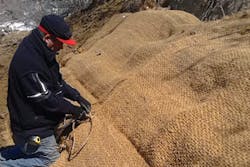Clearing a Pond With Living Logs and Bacterial Enzymes
Rescuing a Pond in Indy
A homeowner in Indianapolis has a small pond, about an acre in size, on his property, used for swimming and fishing. But he was having a number of issues with the pond.
The outfall had been severely damaged, erosion was occurring on the banks, and the water was exhibiting high turbidity.
The pond had been treated a couple times for algae, but not very successfully. The property owner called in J. Eric Spangler of Hoosier Aquatic Management to try to resolve the various problems.
“We did two things,” says Spangler. “We used the vegetated Living Log, from Living Log Aquatic Services, around the shoreline, and we got that stabilized.
“Then on the outfall, we used vegetated soil tubes. These are like big sand bags made out of nonwoven geotextiles. We created a weir structure for the outfall, so we got the water running where it needed to be. The water had eroded the banks and then it blew out the outfall, so then it got too low, causing even more erosion.
“In addition, we also did some bacterial enzyme treatments to get rid of the organic solids and general muck that were at the bottom. This, in conjunction with the Living Logs, really helped out with the water quality and it increased the dissolved oxygen.”
Spangler estimates that turbidity was reduced by 60–70%.
“Previously, you could see a foot down or so. Now you can see to the bottom, and it’s about 10 feet deep.”
He explains that although the structural work is completed, he is still treating with the bacterial enzyme a couple of times a year.
“Because it’s in a wooded area, there’s a lot of leaf litter in the fall, and this breaks down. So it’s an ongoing treatment from the bacterial enzyme standpoint.”
Spangler estimates that he used about 250 feet of the Living Logs around the pond shoreline, and roughly another 30 feet for the weir structure. The Living Logs were built with a variety of wetland species, including marsh milkweed, different sedges, and some iris plants.
To build the weir, he had to dewater a bit, dropping the water level perhaps 18 inches below where it had been. But after the weir was in place, the water level rose about 3 feet, thereby going above its prior level.
Other than the occasional bacterial enzyme treatment, not a great deal of maintenance is required. “We do go through to see if any invasive species are trying to get established on the shoreline,” he says. “So far, this hasn’t been a major issue. We go out about four times a year, so we’ve got a pretty good handle on it.”
Fortunately for the property owner, no special approvals were required. Spangler notes that most projects under 300 linear feet are exempt from the permitting process in Indiana, and this project fell just under that threshold.
He adds that the work was scheduled outside the rainy season to avoid the need for bypass pumping. The project was completed within a couple of days. With the material Spangler used, access wasn’t a problem, either.
“That’s the nice thing about the logs and the soil tubes. We can get them into areas with very difficult access. It’s often a ‘throw it over your shoulder’ thing. We don’t really use any heavy equipment.”
As for the property owner, he is “ecstatic” according to Spangler. After less than satisfactory results from the earlier algae treatment, he is now thrilled with the appearance of his private pond.


